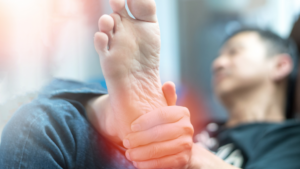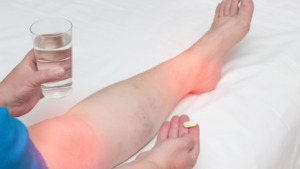Various conditions, diseases, deformities, or injuries cause foot pain. Medications are a common approach to getting relief, but many options don’t involve pills or taking medicine.
Causes of Foot Pain
Diseases, viruses, fungi, and bacteria can cause foot pain, but one of the most common causes of foot pain is arthritis. Pain in the feet is associated with overuse of ligaments or nerve injuries. These are some other common causes for foot pain:

Foot Pain Causes, Home Remedies, and Treatments
- Ingrown toenail
- Plantar warts
- Athlete’s foot
- Diabetes
- Systemic diseases – such as lupus, gout, and rheumatoid arthritis
- Ill-fitting shoes or high heels
- Tendonitis
- Bone Spurs
If you experience foot pain, seeing a specialist is best. Delaying treatment can result in complications, chronic pain, or long-term disabilities.
How To Alleviate Foot Pain
OTC pain relievers can help inflammation and pain, but always consult your doctor before taking anything for your foot pain. Instead, treat yourself with at-home remedies to help minimize the pain.
RICE Method
Rest, ice, compression, and elevation.
If your foot pain is due to injury or overuse, resting it is one of the best ways to help lessen the pain. Rest will allow the tissues to heal and give your body time to process the injury. Ice should not be used for more than 20 minutes at a time. Wrap ice in a towel or plastic bag so it is not too cold on your skin.
Both compression and elevation help prevent swelling of the painful or injured area. Swelling can cause nerve fibers to stretch, causing more pain. Decreasing swelling often provides some degree of pain relief.
Foot Massage
Massages improve circulation, reduce tension, and can help alleviate pain. If you have foot pain, this is a good way to examine your feet, see if the pain worsens, and notice a problem before it worsens.
Trying a hydromassage is another way to help relieve pain. To do this, fill one large bowl or basin with cold water, and another with hot water. Place both feet in the cold water for 5 minutes, then moving to the hot water. Alternate every 5 minutes.
If your pain lasts longer than 5 days (with home treatments) and does not improve after a few weeks, schedule an appointment with a medical professional. Use the form below to get in touch with one the team at Progressive Pain Management.
Lower extremity pain is commonly due to overuse and inflammation as a result of conditions that affect bones, joints, muscles, tendons, and other organs. The key to pain is understanding what causes it. Only physicians can truly diagnose this kind of pain. There are a few questions to ask when diagnosing pain in your legs, hips, thighs, ankles, and lower joints.
- Is there a recent trauma? Falls to the ground are a common cause for lower extremity pain. This is especially true when a patient is unable to recall periods of time or suffers from a drug withdrawal. There is a chance of fracture, so radiographs should be taken.
- Is the pain articular or non-articular? Articular pain (meaning joint pain) is often accompanied by inflammation or swelling. Non-articular pain is musculoskeletal pain and affects muscles and bones. These differentiating symptoms help physicians diagnose the potential source of the pain.
- What is the root of the pain? When determining and understanding the root of the pain, physicians consider a broad variety of symptoms and characteristics regarding your pain. Things like infection, inflammation, vascular, and neoplastic causes can disguise other sources of pain.

Lower Extremity Pain
Being able to answer those questions helps pain doctors diagnose pain and recommend effective treatments for lower extremities. The term “lower extremities” includes the pelvis and hip joint, thigh, knee, lower leg, ankle, and feet.
Types of Lower Extremity Pain
Ankle
Because your ankle bears the weight of your entire body, it is prone to injury. The ankle is a complex network of bones, tendons, muscles, and ligaments. This means there are a lot of things that can cause pain.
Ankle pain can be caused by a number of conditions, including, but not limited to:
- Achillies tendonitis
- Gout
- Osteoarthritis
- Plantar Fasciitis
- Sprained Ankle
- Stress Fractures
Thigh
Pain in your thigh commonly starts in nerves that surround the hip and radiate down. Muscle pain, nerve pain, and injuries are all factors to consider when looking at thigh pain.
Pain may be caused by:
- Bernhardt-Roth syndrome
- Overuse
- Sciatica
- Peripheral Neuropathy
- Sprained or torn ligament
- Blood clots
Foot
Foot pain can be caused by overuse and conditions that cause inflammation like injury to tendons or ligaments in the foot. Arthritis is a common cause of foot pain. The bottom of the foot has a network of nerves that cause immense burning sensations, numbness, or tingling when damaged.
Common causes of foot pain include:
- Osteoarthritis
- Mortnon’s Neuroma
- Plantar Fasciitis
- Gout
- Diabetic Neuropathy
- Tendonitis
Lower Leg
A wide variety of conditions and injuries can cause leg pain. Generally, the leg pain is a cause of tissue inflammation. This can be a result of injury or chronic diseases. The leg contains many different types of tissues and bone structures, making injury and pain very common.
Leg pain can be caused by:
- Shin Splints
- Stress Fractures
- Diabetic Neuropathy
- Peripheral Artery Disease
- Sciatica
- Deep Vein Thrombosis
Hip and Pelvis
Hip and pelvis pain can be difficult to diagnose. The movement of the hip joint, lower back, and leg bones are all connected by a large network of muscles, ligaments, tendons, and joints. Pain from another area of the body frequently causes pain in the hip and pelvis region. This is called referred pain.
Sources of pain can include:
- Bone Fractures
- Arthritis
- Nerve Damage
- Muscle Injury or Inflammation
Knee Joint
If you use your knees to repetitively kneel or lift heavy objects, you may experience knee pain. Knee pain affects people of all ages. Injuries are common and regularly affect the ligaments, tendons, or fluid-filled sacs surrounding the bone. Cartilage in the knee also gets damaged from normal wear and tear, which can cause pain.
Common causes for pain include:
- Osteoarthritis
- Meniscal Injuries
- Cysts
- Gout
- ACL tears
- Bursitis
Treatment Options
Once a diagnosis has been made, your physician will create a treatment plan specific to your pain. If the cause is musculoskeletal, non-steroidal medications or acetaminophen may be used. If pain persists, stronger medications may be prescribed, although it is rare that narcotics are needed.
If the pain is articular, corticosteroid injections may be used to reduce pain. Muscle and tendon pain can be reduced using physical therapy. However, if the muscle pain is due to arthritis, physical therapy may not be helpful.
Your doctor will work with you to form an effective treatment plan that fits your lifestyle and provides the greatest success in restoring a higher quality of life. Fill out the form below to get in touch with the team at Progressive Pain Management.

